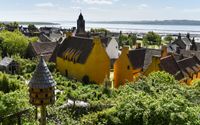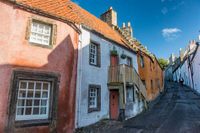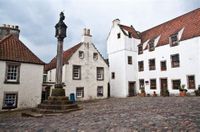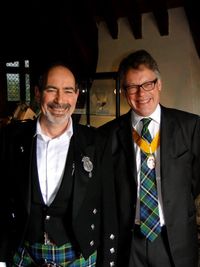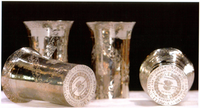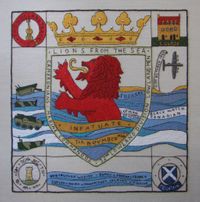De relatie van Veere met Schotland
In 1998 is de Stichting Veere-Schotland opgericht om de eeuwenlange Schotse relatie met Veere opnieuw onder de aandacht te brengen en om de Schotse cultuur nieuw leven in te blazen.
Handelscontacten
Al meer dan 700 jaar is er een relatie tussen Veere en Schotland. Vanaf de 13de eeuw deden Veerse vissers Schotse havenplaatsen aan. Deze contacten in de Middeleeuwen én het huwelijk in 1444 van Wolfert VI van Borselen, Heer van Veere, met de prinses Mary Stuart, dochter van de Schotse koning James I, resulteerden in 1541 in een stapelcontract, waarin de Schotten vastlegden dat importgoederen vanuit diverse steden, verenigd in de ‘Convention of Royal Burghs in Scotland’ uitsluitend in Veere opgeslagen en verhandeld zouden worden. Tot deze steden behoorden onder meer Edinburgh, Aberdeen, St. Andrews en Culross. Een van de belangrijkste importgoederen was de wol, bestemd voor onder andere de Vlaamse lakenindustrie.
De handelscontacten met Schotland brachten Veere grote welvaart. De Schotse kooplieden die zich hier mettertijd vestigden, bezaten pakhuizen, administratieve centra, woonhuizen en een eigen kerk met dominee; tevens mochten ze hun eigen rechtspraak blijven uitoefenen en waren ze vrijgesteld van accijns.
Schotten in Veere
Op straat werd Schots gesproken, kon men diverse ‘tartans’ (geruite stoffen) zien, kwam men mensen in ‘kilts’ tegen met namen als Cunningham, Olyphant, Tennant of Gregory en kon men soms een ‘piper’ horen spelen.Veere verloor het stapelrecht in 1799 en de Schotse episode uit het verleden van Veere verzonk langzaam in de vergetelheid. Thans herinneren nog een aantal gebouwen aan de Schotse aanwezigheid. Het huis ‘De Swane’ aan de Markt was van 1541 tot 1616 de plaats van samenkomst van de Schotse natie voor hun rechtszittingen en festiviteiten. De huizen ‘Het Lammetje’, ‘De Struys’ (nu ‘Schotse Huizen’), ‘De Oliphant’ en ‘De Wolzak’ zijn in de 16de eeuw voor Schotse kooplieden gebouwd. Meer lezen? Kijk onder tabblad 'contact' voor een boekje over de Schots-Veerse relatie.
Boven: gevelsteen van de Schotse Huizen, met een lam, verwijzend naar de wolhandel met Schotland.
Onder: de zgn. 'Schotse Huizen' aan de Kaai, gebouwd door en voor Schotse handelaren in de 16de eeuw.
Culross
In de jaren ‘80 was het de National Trust of Scotland die deze historische relatie aan de vergetelheid ontrukte. Een groot restauratieprogramma had van een van de Schotse koopsteden, Culross, een schilderachtig stadje gemaakt, op eenzelfde schaal als Veere. In de vroege jaren ‘90 werd de Vereniging Vrienden van Veere erbij betrokken en de samenwerking resulteerde in een expositie in het oude stadhuis van Culross en de naamgeving van een nieuwe straat, ‘Veere Park’.
Boven en links: impressies van het Schotse Culross, net als Veere aan zee gelegen
Er komt weer Schot in
In 1996 was de oude relatie met Schotland al zover ingeburgerd dat er bij het 700-jarig bestaan van de stad Veere een ‘Schotse Week’ werd georganiseerd, met diverse activiteiten. Bij die gelegenheid werd Dr. Winifred Ewing, voormalig MEP en President van de Scottish National Party benoemd tot ‘Honorary Conservator of the Scottish privileges in the Netherlands’, een titel die sinds 1799 verdwenen was. De huidige ereconservator is de heer Neil Wallace.
Mr. Neil Wallace (left) with the silver conservator's badge, given on loan by Mr. John Dermot Turing (right). Mr. Turing is a descendant of the Aberdeenshire family Turing, who lived in Veere and were active as merchants.
Enkele enthousiaste ‘Scottofielen’ richtten niet lang daarna een werkgroep Veere-Schotland op, teneinde de activiteiten wat meer te coördineren. Vanuit de werkgroep ontstond in 1998 de Stichting Veere-Schotland, opgericht om de Schotse cultuur in Veere opnieuw onder de aandacht te brengen én daadwerkelijk nieuw leven in te blazen.
De stichting heeft sindsdien diverse activiteiten georganiseerd, van ceilidhs, Halloween-spooktochten, high tea's, lezingen, rondwandelingen, concerten, etc.
|
Scottish Diaspora Tapestry
Van 2012 tot 2014 is er in 34 landen gewerkt aan panels voor het Scottish Diaspora Tapestry, een meterslang wandtapijt met in totaal 305 delen. HIEROVER LATER MEER.
THIS SITE IS STILL UNDER CONSTRUCTION
Veere-Scottish
relations
throughout history
Veere is in Zeeland, near Middelburg on the now landlocked ‘island’ of Walcheren. It has a small picturesque harbour, which once gave direct access to the North Sea. Old fortifications have defined its layout, dominated by the huge Church of Our Lady (Grote Kerk) and by the elegant Late Gothic Town Hall. Many buildings recall a prosperous period in the town’s history when it was the centre of the wool trade with Scotland and Scottish merchants lived here.
Trade
In the 12th century, wool production in Scotland and England began to outstrip domestic demand, so the Cistercian monks of Melrose exported Scottish wool dutyfree to Flanders. This right was formalised in 1407 by a decree of the Duke of Burgundy which created the office of Conservator of Scottish Privileges in the Low Countries. Huge amounts of wool were exported for manufacture into cloth in the Low Countries, France and German towns on the North and the Baltic Seas.
Founded as a fishing port in 1296, Veere soon made contact with Scottish ports and exchanged all kinds of goods. At this time, Scottish wool was exported to Bruges, but when the River Zwin silted up the ports of entry, Damme and Sluis, could no longer be navigated. Despite all the efforts of Bruges to retain the Scottish Wool Staple the Conservator of Scottish Privileges, Sir Alexander Napier, eventually transferred his Office and Staple Court to Middelburg in 1518. Another factor in this move was the growing pressure from Spain and France to assert the Roman Catholic rite in Flanders. When this pressure began to be felt in Middelburg, the Staple was again moved in 1541 to Veere, where the local people sympathised with the Calvinist views of the Scottish trading community.
Staple Contract
The Staple Contract granted Veere a monopoly on importing, storing and trading Scottish goods in the Netherlands.
The Veere-Scotland ties had been strengthened by the marriage in 1444 between Wolfert VI of Borssele, Lord of Veere, and Mary Stuart, the daughter of the Scottish king James I and Joan Beaufort. Mary died in 1465 and was buried in the Grote Kerk. The links between the Stuarts and the Netherlands continued with the marriage of Prince William of Orange (Marquis of Veere) to the daughter of James VI.
The Scottish traders (who came mainly from Edinburgh, Perth, Culross, St. Andrews, Dundee and Aberdeen) received several privileges in the town they called Campvere. The Scots’ ships were given preferential treatment and they had their own taxation and legal system. The ‘Admiral’s Court’ dealt with international maritime law, such as in 1528 when the city of Edinburgh appealed to the Lord of Veere for justice in the case of a dispossessed Scottish skipper. The 'Court of the Lord Conservator' dispensed justice independently in both civil and criminal cases to all who lived under the Staple Contract. In a historical account of the Staple, the Deputy Conservator, James Stuart, wrote in 1749 that 'the Scots' Privileges in the Netherlands are the most honorable that were ever granted to any Nation in that, or perhaps any other Country'.
Scottish Kirk on foreign soil
In 1612 the Scottish community was given the right to establish a chapel with a graveyard and to appoint ministers and elders. This was the first Scottish Kirk established on foreign soil and linked directly with the General Assembly in Edinburgh. Its first minister was Alexander MacDuff, who took up his charge in 1614. Four engraved silver communion cups, made by a local silversmith, were in use from 1620 to 1798 (see picture). In 1875 they were offered for sale as ‘old silver’ and bought by a wealthy landowner, who presented them to Manchester Cathedral in 1893, where they remain. Veere thus became in the 15th and 16th centuries the main port for Scottish commerce with Flanders, Holland and Brabant. Wool was the major import, next to coal, hides, whisky, flax, grain and fish. Exported to Scotland were cloth, tiles, leather, brassware, wines and spirits. There is a reference to a ‘very good, tame lion’, which was sent to the Scottish king as a gift from the people of Veere!
Evidence for a settled Scottish community is provided by the story of Sir Thomas Cunningham, who was born in Veere in 1604 and lived there all his life, becoming both Scottish Conservator and Mayor.
End of the trade
The Napoleonic period saw the end of the wool trade and the Scottish Privileges. The Scottish Staple was based on privileges which did not accord with the principles of égalité espoused by the new French influenced Batavian Republic. With the coming of free trade, Veere’s prosperity and wealth had already declined. In 1798 the Scottish community in Veere had dwindled to 15 souls; the Kirk was closed and the minister, Rev. James Likly of Aberdeen, was expelled. The elders wrote to the Presbytery in Edinburgh: ‘How much we now regret the loss of public worship in our own language, the dispersion of our congregation and the loss of our Pastor, so justly esteemed and respected by us (...)’.
The 1st of December 1799 saw the cancellation of the Scottish Staple Contract. All persons under the former jurisdiction of the Scottish Court had to leave the Republic so the Scots quit Veere and returned to their own country. The Scottish church was demolished in 1837.
Liberation
The title of ‘Honorary Conservator of the Scottish Privileges in the Low Countries’ was revived when Veere celebrated its 700th anniversary in 1996; the title was granted to Mrs Winifred Ewing, Member of the European Parliament. Now the title is in the hands of Mr. Neil Wallace.
Appropriately it was the Scots of the 52nd (Lowland) Division who liberated Veere in November 1944, and this event was commemorated with the unveiling of a memorial in November 1998 attended by invited Scottish Veterans.
(One of the panels of the Scottish Diaspora Tapestry, made by stitchers from Veere.)
Operation ‘Infatuate’ (November 1-8, 1944) concerned the liberation of Walcheren, then occupied by the Germans, a crucial phase in the battle of the river Scheldt, the access to the port of Antwerp. Veere was liberated on November 7, 1944 by Scottish troops. These were the 156th Infantry Mountain Brigade consisting of 6th and 7th Cameronians (‘Scottish Rifles’ with commanding officer C.F. Nason), 5th Company of the HLI (Highland Light Infantry), 1st Glasgow Highlanders (HLI) of the 52nd Lowland Division (lead by E. Hakewell Smith), along with the Royal Engineers and Royal Artillery.
Dutch archaeologist, Christina Polderman and Veere town archivist Peter Blom have founded a Scotland-Veere ‘Stichting’ (organization) to foster closer links. They are also interested in exchanging records of the medieval trade with Scottish historians with a view to a future exhibition.
Text : Christina N. Polderman, Secretary Scotland - Veere Organization and David Paterson, former director of DA Study Tours in Culross which ran tours to Veere.
Published in the Scottish Local History Journal, vol. 48, Spring 2000.

